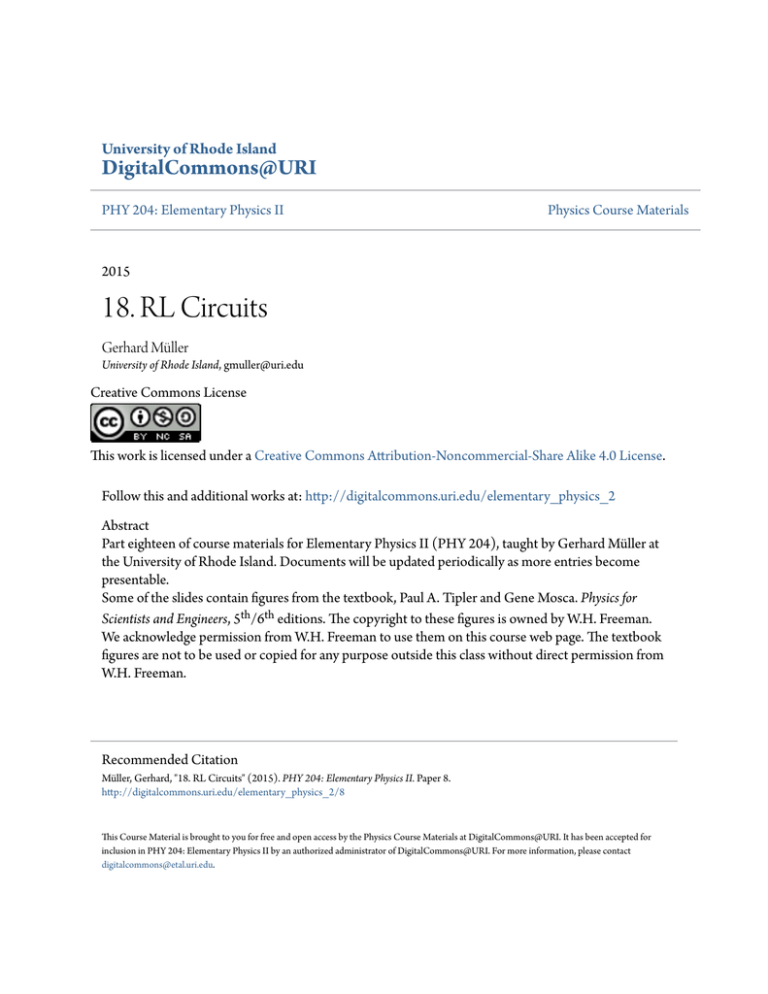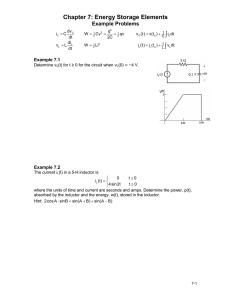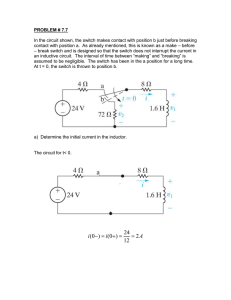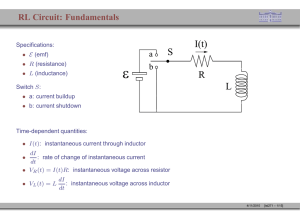18. RL Circuits - DigitalCommons@URI
advertisement

University of Rhode Island DigitalCommons@URI PHY 204: Elementary Physics II Physics Course Materials 2015 18. RL Circuits Gerhard Müller University of Rhode Island, gmuller@uri.edu Creative Commons License This work is licensed under a Creative Commons Attribution-Noncommercial-Share Alike 4.0 License. Follow this and additional works at: http://digitalcommons.uri.edu/elementary_physics_2 Abstract Part eighteen of course materials for Elementary Physics II (PHY 204), taught by Gerhard Müller at the University of Rhode Island. Documents will be updated periodically as more entries become presentable. Some of the slides contain figures from the textbook, Paul A. Tipler and Gene Mosca. Physics for Scientists and Engineers, 5th/6th editions. The copyright to these figures is owned by W.H. Freeman. We acknowledge permission from W.H. Freeman to use them on this course web page. The textbook figures are not to be used or copied for any purpose outside this class without direct permission from W.H. Freeman. Recommended Citation Müller, Gerhard, "18. RL Circuits" (2015). PHY 204: Elementary Physics II. Paper 8. http://digitalcommons.uri.edu/elementary_physics_2/8 This Course Material is brought to you for free and open access by the Physics Course Materials at DigitalCommons@URI. It has been accepted for inclusion in PHY 204: Elementary Physics II by an authorized administrator of DigitalCommons@URI. For more information, please contact digitalcommons@etal.uri.edu. RL Circuit: Fundamentals Specifications: a • E (emf) • R (resistance) • L (inductance) ε S b I(t) R L Switch S: • a: current buildup • b: current shutdown Time-dependent quantities: • I(t): instantaneous current through inductor dI : rate of change of instantaneous current dt • VR (t) = I(t)R: instantaneous voltage across resistor • • VL (t) = L dI : instantaneous voltage across inductor dt 4/11/2015 [tsl271 – 1/15] RL Circuit: Current Buildup in Inductor dI =0 dt dI E/R − I dI = E − IR ⇒ = • Differential equation: L dt dt L/R „ « Z I Z t dI E/R − I dt t = ⇒ − ln = E/R L/R 0 E/R − I 0 L/R i E h −Rt/L 1−e • Current through inductor: I(t) = R dI E −Rt/L • Rate of current change: = e dt L • Loop rule: E − IR − L I(t) ε ε ⇒ E/R − I = e−Rt/L E/R dI/dt L R t t 4/11/2015 [tsl272 – 2/15] RL Circuit: Current Shutdown in Inductor dI =0 dt dI dI R • Differential equation: L + IR = 0 ⇒ =− I dtZ dt L Z I R t R I I dI =− =− t ⇒ = e−Rt/L dt ⇒ ln ⇒ L 0 E/R L E/R E/R I • Loop rule: −IR − L E −Rt/L e R E dI = − e−Rt/L • Rate of current change: dt L • Current: I(t) = I(t) ε ε −dI/dt L R t t 4/11/2015 [tsl273 – 3/15] RL Circuit: Energy Transfer During Current Buildup Loop rule: IR + L dI =E dt (I > 0, dI > 0) dt • IE: rate at which EMF source delivers energy • IVR = I 2 R: rate at which energy is dissipated in resistor • IVL = LI dI : rate at which energy is stored in inductor dt Balance of energy transfer: I 2 R + LI dI = IE dt a ε b S I(t) R L 4/11/2015 [tsl274 – 4/15] RL Circuit: Energy Transfer During Current Shutdown Loop rule: IR + L • IVL = LI dI =0 dt (I > 0, dI < 0) dt dI : rate at which inductor releases energy dt • IVR = I 2 R: rate at which energy is dissipated in resistor Balance of energy transfer: I 2 R + LI dI =0 dt a ε b S I(t) R L 4/11/2015 [tsl275 – 5/15] RL Circuit: Some Physical Properties Specification of RL circuit by 3 device properties: • E [V] (emf) • R [Ω] (resistance) ε S R L I(t) • L [H] (inductance) Physical properties of RL circuit during current buildup determined by 3 combinations of the device properties: ˛ dI ˛˛ E = • : initial rate at which current increases L dt ˛t=0 E = I(t = ∞): final value of current R • L/R = τ : time it takes to build up 63% of the current through the circuit [1 − e−1 = 0.632 . . .] • 4/11/2015 [tsl276 – 6/15] RL Circuit: Application (7) In the circuit shown the switch S is closed at time t = 0. (a) Find the current I as a function of time for 0 < t < tF , where tF marks the instant the fuse breaks. (b) Find the current I as a function of time for t > tF . 4A fuse 15 Ω 12V I 5H S 4/11/2015 [tsl284 – 7/15] RL Circuit: Application (8) In the circuit shown the switch has been open for a long time. Find the currents I1 and I2 • just after the switch has been closed, • a long time later, • as functions of time for 0 < t < ∞. S R 2 = 10 Ω ε = 12V Ι1 R1 = 5 Ω Ι2 L = 5H 4/11/2015 [tsl285 – 8/15] RL Circuit: Application (6) In the RL circuit shown the switch has been at position a for a long time and is thrown to position b at time t = 0. At that instant the current has the value I0 = 0.7A and decreases at the rate dI/dt = −360A/s. (a) Find the EMF E of the battery. (b) Find the resistance R of the resistor. (c) At what time t1 has the current decreased to the value I1 = 0.2A? (d) Find the voltage across the inductor at time t1 . a ε b S R L = 0.3H 4/11/2015 [tsl283 – 9/15] RL Circuit: Application (5) Each RL circuit contains a 2A fuse. The switches are closed at t = 0. • In what sequence are the fuses blown? (1) 6V S 1H (2) 1Ω 1H (3) 6V S 2A 1H 2A 1H 1Ω 1H 1Ω 1Ω (4) 2A 1Ω 1H 6V S 1Ω 6V S 2A 1H 1Ω 1Ω 1H 4/11/2015 [tsl282 – 10/15] RL Circuit: Application (3) The switch is closed at t = 0. Find the current I (a) immediately after the switch has been closed, (b) immediately before the fuse breaks, (c) immediately after the fuse has broken, (d) a very long time later. 4A fuse 15 Ω 12V I 5H S 4/11/2015 [tsl280 – 11/15] RL Circuit: Application (1) Each branch in the circuit shown contains a 3A fuse. The switch is closed at time t = 0. (a) Which fuse is blown in the shortest time? (b) Which fuse lasts the longest time? R=6 Ω S 12V 1 L=6H 2 C=6F 3 4/11/2015 [tsl278 – 12/15] RL Circuit: Application (4) Find the magnitude (in amps) and the direction (↑, ↓) of the current I (a) right after the switch has been closed, (b) a very long time later. S 12V 1Ω 1F 1Ω 1H I 1Ω 1Ω 4/11/2015 [tsl281 – 13/15] RL Circuit: Application (2) The switch in each RL circuit is closed at t = 0. Rank the circuits according to three criteria: (a) magnitude of current at t =1ms, (b) magnitude of current at t = ∞, (c) time it takes I to reach 63% of its ultimate value. (1) S 1H (2) 6V 1Ω 1H (3) 1H 1Ω 1H 1Ω (4) 6V S 1Ω 1H 1H 1Ω 6V S 6V S 1Ω 1H 1Ω 1Ω 1H 4/11/2015 [tsl279 – 14/15] Intermediate Exam III: Problem #2 (Spring ’05) In the circuit shown we close the switch S at time t = 0. Find the current I through the battery and the voltage VL across the inductor (a) immediately after the switch has been closed, 5H (b) a very long time later. 4Ω 2Ω 2Ω 12V S Ι 4/11/2015 [tsl343 – 15/15] Intermediate Exam III: Problem #2 (Spring ’05) In the circuit shown we close the switch S at time t = 0. Find the current I through the battery and the voltage VL across the inductor (a) immediately after the switch has been closed, 5H (b) a very long time later. 4Ω 2Ω 2Ω 12V Solution: 12V = 1.5A, (a) I = 2Ω + 4Ω + 2Ω S Ι VL = (4Ω)(1.5A) = 6V. 4/11/2015 [tsl343 – 15/15] Intermediate Exam III: Problem #2 (Spring ’05) In the circuit shown we close the switch S at time t = 0. Find the current I through the battery and the voltage VL across the inductor (a) immediately after the switch has been closed, 5H (b) a very long time later. 4Ω 2Ω 2Ω 12V Solution: 12V = 1.5A, VL = (4Ω)(1.5A) = 6V. (a) I = 2Ω + 4Ω + 2Ω 12V = 3A, VL = 0. (b) I = 2Ω + 2Ω S Ι 4/11/2015 [tsl343 – 15/15]




